If you research historical or movie clothing for some time, then you will probably stumble over some more or less interesting things.
This, at least, happened several times to me; and I think I will just list them here. If I should find something new, I’ll add it to the top of this page.
- The Stargate Atlantis boobs swindle
The following picture is the original promotion picture for an episode of Stargate Atlantis, taken directly from the corresponding episode page at Gateworld.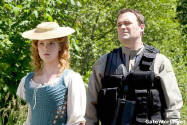
This picture, by the way, cropped to just the actress, is also used for Erin Chambers‘ (the actress) Stargate Atlantis autograph cards for her character ‚Sora‘ which you can occasionally find on Ebay:
Besides me thinking that this corset looks much as if it was directly made from a certain Butterick pattern without adding much variation except of the front side lacings,…
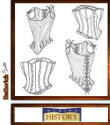
…you have three guesses which stays I could possibly mean…
…I found something odd about the picture; but for a long time I couldn’t figure out what it was.When I was bored, I enlarged the picture to find out what was so odd about the picture, and then I found it:



Left picture shows the unedited, original but enlarged and cropped version of the costume; the center one has some red darts in it to indicate the oddities. To the right you can see a screen capture of that particular scene from the actual episode (which, of course, has not been photoshopped) to make even clearer what I mean.
As you can see in the middle picture, parts of the picture have obviously been heavily photoshopped – and by a complete idiot, as it seems.
The sleeve on the left side has been cut off in the middle of her arm; the corset’s lacings are photoshopped in a way that they seem to be double and one of the lacings on her chemise (which hangs over the upper edge of the corset) has obviously also been cut off. Also, this upper edge of the corset – or stays, rather – is not a straight line any more but has an interesting ‚dent‘ (also indicated by red arrows).
(Note for all non-costumers being confused by the terminology I am using:
The white thing that can be seen along the neckline and the sleeves are parts of a so-called chemise; that is some kind of long-sleeved shirt. The blue thing over that chemise is something that historically would be called ‚pair of bodies‘ (this is where the word ‚bodice‘ comes from!) or ’stays‘, which would – again, historically – later be called a ‚corset‘ but work a little different the way they are shaped. They are not supposed to reduce the waist size – as Victorian corsets do – but just to give a conical, straight shape to the torso which was fashionable from about Elizabethan to Rococo times. It is, in fact, impossible to reduce the waist with such stays.
This is why I laugh each and every time I see ‚Pirates‘ and hear ‚Elizabeth‘ curse about being in pain because of her „corset“ – those *stays* can’t cause pain because of their unique construction…)
Anyway… back to Sora’s blue stays.
I wondered for quite some time why on earth anyone would do something like this – the photoshpopping, I mean.
Then I decided to practically restore the original image, meaning to undo that heavy and not even remotely skilful photoshopping.

Left picture shows – again – the unedited original picture, right one shows my ‚restored‘ version.
And if you now open the above shown two pictures in new windows and place those windows right next to each other, you will see that the photoshopping was obviously just done for one particular reason: to make the actresses‘ chest look bigger that it naturally is!
*Lol* – no, honestly, Stargate Atlantis *is* a great show – why do they think they need bigger boobs in their promotional pictures to make it more popular…?
The ‚corset‘ worn here is much likely to Rococo stays – in fact, the Butterick pattern of which I still think that it was used to produce this costume indicates that these *are* Rococo stays.
Those stays are *supposed* to flatten the chest in order to push it up, which of course can’t be seen as the chemise worn below is way too high. Plus the stays are supposed to give a conical, straight shape to the torso – which, as can be seen in my ‚restored‘ version of the picture, they do pretty well.
Why do the costumers of that show take a pattern for something that will flatten the chest and straightens the torso if they would like to achieve the exact opposite effect…? *shakes head*
Oh, and of course it should be said that stays historically are *underwear*. They are supposed to be worn *below* something else, like, for example, a dress, and no, not even a working woman would have worn stays as a bodice – but hey, that’s Stargate Atlantis, different galaxy and such – perhaps there, it is much common to use Simplicity-pattern-based pseudo-historical underwear as everyday dresses…? (I’m currently having an image of McKay in my mind, going on a mission in shorts with some kind of sweet hearts print and a white tank top, I can’t help it!) 😉
(Did I mention that I would find that costume – in the non-photoshopped version – much interesting for a Stargate convention? At least I would have another use for those stays as soon as the convention would be over – wearing them as underwear with a different, historically correct costume, that is… *snickers*… well, if I should accidentally stumble over some dull-blue-green linen, I think I’ll make it… but add it to my list of planned costumes first ;-))
You’ll probably all know this portrait:

That’s Jane Seymour, third wife of Henry VIII. and mother to King Henry’s only (surviving) male heir, Prince Edward (later King Edward VI; died at the age of 16).
The most interesting thing in this portrait – for you – is now the nice brooch Jane is wearing: The one that seems to spell UTIS, but actually spells IHS (that’s a monogram of the name of Jesus Christ). You can’t miss it if you look at the portrait.
Now, here’s another image.
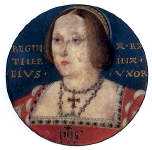
That’s Catherine of Aragon; first wife of Henry VIII and daughter Ferdinand of Aragon and Isabella of Castile. Yes, that mother was *the* Isabella „The Catholic“, who gave money to Columbus to ‚discover‘ a way to India, which lead him to America!
She was also the mother of Mary, who would much later send Elizabeth into the tower.
And now… if you shouldn’t have believed your eyes when seeing the last picture…
Hold your breath… here’s a close-up of the same area in both portraits…
Can you see that?
That’s Jane Seymour, third wife of Henry, wearing jewelry that obviously once belonged to Catherine of Aragon, first wife of Henry!
Furthermore, it almost looks as if the gown that Jane is wearing is *somehow* (though not exactly) a copy of Catherine’s gown, or at least a very, very similar one – I can’t believe in just a strange coincidence here…
I *knew* that Catherine was, after the divorce from Henry, forced to hand over all her jewels to him, which would then be worn by his second wife, Anne Boelyn (who was, by the way, the mother of Elizabeth I.) – but that here is just ridiculous…
Henry VIII, master in women’s jewelry recycling – or what…?
Yes… there’s a difference.
Let’s have a look at this portrait:

That’s the „Ermine“ Portrait by Nicholas Hilliard or William Segar,
painted c. 1585, it can be seen at Hatfield house.
Now, big question:
There is an animal on Elizabeth’s left arm (right arm in the painting). How is that animal called?
(And if you would like to answer „Ermine“, then you’re wrong. Ermines look different.)
(Yes, I know where the portrait got its name from! Please consider reading on, will you…?)
No, seriously. I *know* that this is *supposed* to be an ermine, but it’s not. An ermine is not a Dalmatian – it doesn’t have spots. The only black spot it has in its white winter fur is usually at the end of its tail. Plus, it’s usually a whole tad bigger – it should be about two times as big, especially longer, than in that portrait. Here’s the ultimate comparison:
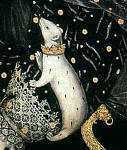 |
 |
| Portrait animal – looks like a mixture between Dalmatian, rat and guinea pig (sorry, Master Hilliard, but truly…!) |
Photograph of a real ermine |
| Funny side note: Madame Tussaud in London exhibits Queen Elizabeth in that outfit – and with a stuffed, real ermine on her arm, so you may see how large such an animal would naturally be (side by side compared with the portrait): 
See more pictures of Elizabeth and some of her stepmothers from Madame Tussaud here. |
And why did Hilliard paint the ermine with spots?
Well, obviously because he had never seen a living one – just what their fur would become if worked into garments.
And this clothing, indeed, *has* black spots – or rather the countless tails of ermines, which were usually worked in a pattern into such garments…
Here is as example the coronation cloak of Queen Elizabeth II.; the white parts of the ermine tails appear slightly yellowish (It’s a bit strange that they left the white parts of the tails there, though. Usually they are cut down to the black tips because – as already mentioned and very well visible in this picture – the tails are often a little yellowish in their white part):
This, I believe, is the reason why Hilliard, never having seen an ermine (and obviously also not a single skinned fur) , painted the animal with spots: He thought that they would look just that way!
This is the perfect proof that Elizabeth respectively her Lady-in-waiting who posed for this portrait never really had an ermine on her arm – this animal sprang from the pure imagination from the artist.
It’s also perfect proof that an incredibly good portrait artist isn’t necessarily also a good nature artist 😉
Take a look at the following pictures:
They all seem to show the same jewel; or at least jewels that are *much*, very much likely to each other.
Now look at the portraits to which they belong (in the order in which the images of the jewel appear above):
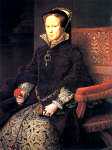

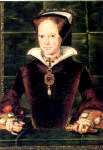
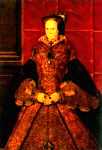
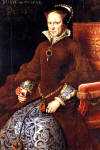



(The jewel is slightly smaller in the last portrait, compared to the others. However, it looks so much like the others – shape, colors – that I think this might be a mistake of the painter.)
Those are – clearly to be seen – as well portraits of Mary Tudor as of Elizabeth I. Coincidence? I don’t think so.
As Mary is wearing the jewel in fairly many portraits, and Elizabeth is wearing it in some, especially in earlier ones, I guess I can draw the following conclusions:
1. This was Mary’s favorite jewel.
2. Elizabeth took it after her death.
3. Elizabeth wore it from time to time, though probably not often (considering the considerable low amount of portraits of her that were painted with it, compared to the large amount of portraits in which Mary wears it)
4. Elizabeth kept it to remember her relative ‚victory‘ over Mary, and used it to show just that in portraits – more in earlier years of her reign than in later. This is why I like to call especially Elizabeth’s „Siena“ portrait the ‚Victory over Mary‘. It’s really a victory that she afterwards got the throne *and* even had the guts to have herself painted with Mary’s favorite jewel so obviously!
The jewel doesn’t seem to appear any more in any portrait after c. 1583. The last portrait in which is appears seems to be the „Siena Sieve“ portrait of Elizabeth. In that portrait, it is worn as a brooch without the top stone.
Look at the following pictures and tell me what they – at least vaguely – have in common:
Right… that’s always almost the same dress, and all the pictures have been painted by Lucas Cranach – but they show different people…
Some more examples of much likely dresses, painted by the same painter:
And, no – I see absolutely no reason why many, many women of a certain period should wear – over the timespan of several years – all red velvet gowns with golden brocade / damask inserts.
I think it’s almost safe to say that either this was the favorite gown of Cranach, or that he had just one Vandyke costume in his Atelier from which he could paint.
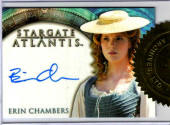
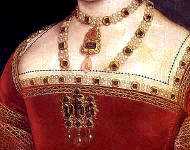
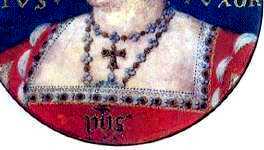
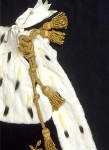
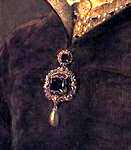
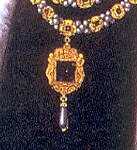
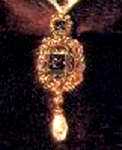
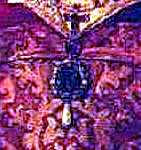
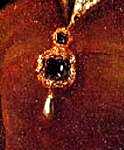
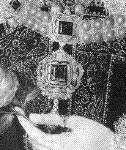
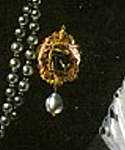
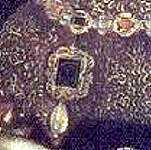



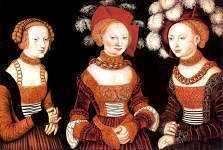

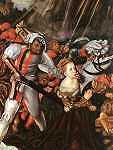
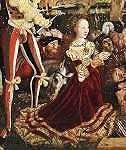


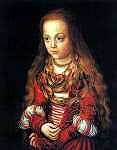


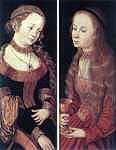

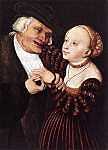


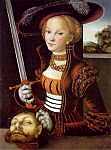
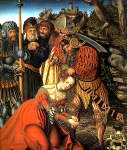
Hi
The Jewel Mary wears is a gift from Phillip ,its from the spanish Royal jewels and the large pearl is the peregrina pearl,I think Elizabeth hung onto it for a while before returning it ,, though it was supposed to go straight back to spain as it was for consorts of the spanish kings,
With the ius jewel – there were actually gems that belonged to ‚the queen‘, and still are – that’s how a lot of portraits of Henry’s wives were identified (they were wearing jewelry that belonged to the crown), which to me seems sad. There are still some of the gems worn in Tudor and Elizabethan portraits that the crown still owns. He really wasn’t doing anything wrong (as far as the jewelry was concerned), as once a woman stopped being queen, the jewels no longer belonged to her.
It could be that Mary’s favorite gem was similar – it was one of ‚the queen’s‘ jewels, and where she really liked it, Elizabeth definitely had *very* different taste so it wasn’t her favorite.